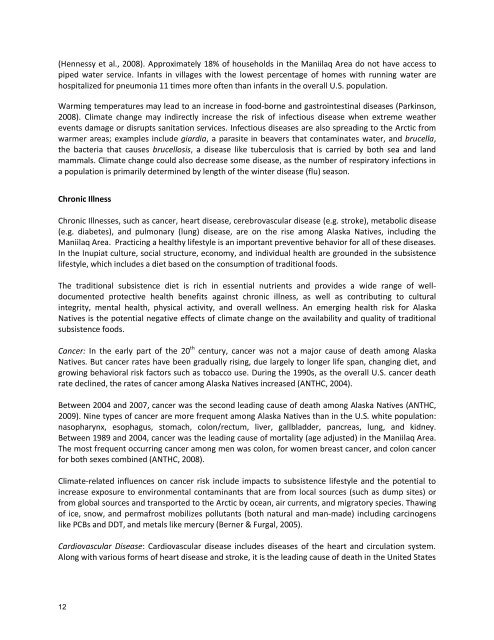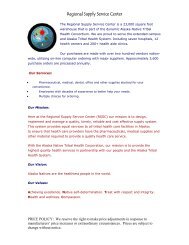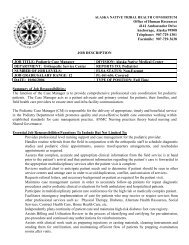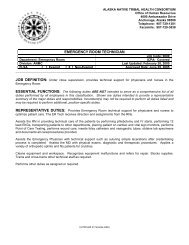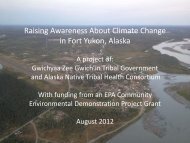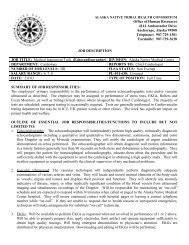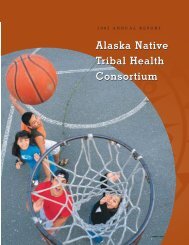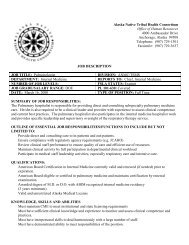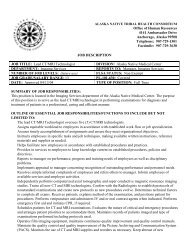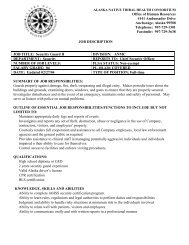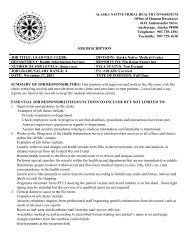Draft Final Climate Change and Health Impacts Point ... - ANTHC
Draft Final Climate Change and Health Impacts Point ... - ANTHC
Draft Final Climate Change and Health Impacts Point ... - ANTHC
Create successful ePaper yourself
Turn your PDF publications into a flip-book with our unique Google optimized e-Paper software.
(Hennessy et al., 2008). Approximately 18% of households in the Maniilaq Area do not have access to<br />
piped water service. Infants in villages with the lowest percentage of homes with running water are<br />
hospitalized for pneumonia 11 times more often than infants in the overall U.S. population.<br />
Warming temperatures may lead to an increase in food‐borne <strong>and</strong> gastrointestinal diseases (Parkinson,<br />
2008). <strong>Climate</strong> change may indirectly increase the risk of infectious disease when extreme weather<br />
events damage or disrupts sanitation services. Infectious diseases are also spreading to the Arctic from<br />
warmer areas; examples include giardia, a parasite in beavers that contaminates water, <strong>and</strong> brucella,<br />
the bacteria that causes brucellosis, a disease like tuberculosis that is carried by both sea <strong>and</strong> l<strong>and</strong><br />
mammals. <strong>Climate</strong> change could also decrease some disease, as the number of respiratory infections in<br />
a population is primarily determined by length of the winter disease (flu) season.<br />
Chronic Illness<br />
Chronic Illnesses, such as cancer, heart disease, cerebrovascular disease (e.g. stroke), metabolic disease<br />
(e.g. diabetes), <strong>and</strong> pulmonary (lung) disease, are on the rise among Alaska Natives, including the<br />
Maniilaq Area. Practicing a healthy lifestyle is an important preventive behavior for all of these diseases.<br />
In the Inupiat culture, social structure, economy, <strong>and</strong> individual health are grounded in the subsistence<br />
lifestyle, which includes a diet based on the consumption of traditional foods.<br />
The traditional subsistence diet is rich in essential nutrients <strong>and</strong> provides a wide range of welldocumented<br />
protective health benefits against chronic illness, as well as contributing to cultural<br />
integrity, mental health, physical activity, <strong>and</strong> overall wellness. An emerging health risk for Alaska<br />
Natives is the potential negative effects of climate change on the availability <strong>and</strong> quality of traditional<br />
subsistence foods.<br />
Cancer: In the early part of the 20 th century, cancer was not a major cause of death among Alaska<br />
Natives. But cancer rates have been gradually rising, due largely to longer life span, changing diet, <strong>and</strong><br />
growing behavioral risk factors such as tobacco use. During the 1990s, as the overall U.S. cancer death<br />
rate declined, the rates of cancer among Alaska Natives increased (<strong>ANTHC</strong>, 2004).<br />
Between 2004 <strong>and</strong> 2007, cancer was the second leading cause of death among Alaska Natives (<strong>ANTHC</strong>,<br />
2009). Nine types of cancer are more frequent among Alaska Natives than in the U.S. white population:<br />
nasopharynx, esophagus, stomach, colon/rectum, liver, gallbladder, pancreas, lung, <strong>and</strong> kidney.<br />
Between 1989 <strong>and</strong> 2004, cancer was the leading cause of mortality (age adjusted) in the Maniilaq Area.<br />
The most frequent occurring cancer among men was colon, for women breast cancer, <strong>and</strong> colon cancer<br />
for both sexes combined (<strong>ANTHC</strong>, 2008).<br />
<strong>Climate</strong>‐related influences on cancer risk include impacts to subsistence lifestyle <strong>and</strong> the potential to<br />
increase exposure to environmental contaminants that are from local sources (such as dump sites) or<br />
from global sources <strong>and</strong> transported to the Arctic by ocean, air currents, <strong>and</strong> migratory species. Thawing<br />
of ice, snow, <strong>and</strong> permafrost mobilizes pollutants (both natural <strong>and</strong> man‐made) including carcinogens<br />
like PCBs <strong>and</strong> DDT, <strong>and</strong> metals like mercury (Berner & Furgal, 2005).<br />
Cardiovascular Disease: Cardiovascular disease includes diseases of the heart <strong>and</strong> circulation system.<br />
Along with various forms of heart disease <strong>and</strong> stroke, it is the leading cause of death in the United States<br />
12


